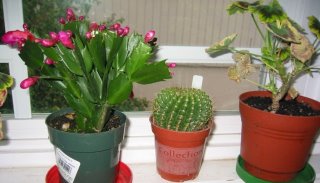Here's a thought. Some plants are grown for their summer appearance, and ave overwintered in order to maintain them for the next year. Or at least, to have new and larger specimens the next year, and save money.
Others are grown for their winter appearance, indoors. They can be oversummered. In this case, oversummering is a chance to grow them larger and more lush. This is in contraast to overwintering, which is basically keeping them dormant or at least not growing rapidly.
Most are left in a shady place or northern exposure, since they aren't really designed for full sun. Some may have started their species as under-story plants in the forest. The epiphytic cacti were suited for growing high in the trees, wlthough there may have been higher branches shading them (speculation on my part). Even plants designed for full sun, were not designed by nature to grow in containers, where they are more likely to dry out and become sunburned. Leaving them in protected locations, they don't need quite as much attention.

These are sort of accidental houseplants. Looking around the yard, I found a tulbagia ("Society garlic") that survived last winter in the ground. The oxalis is somewhat tender but somehow escaped into the bean garden. Today I potted up both, to see how they will do in containers again. This photo is basically a 'before' picture.

Some cactus cuttings. These fell off of the Brasilopuntia when I repotted it. This is all it takes to start them.

One year old epiphullum hybrid. It's increased in size, no flower buds yet.

Another epiphyllum hybrid. Same story as the other one.

Here's an aloe that I bought last week at an estate sale. It wasn't labeled for sale. Some poor old soul had left it in a corner of the house and it hadn't been thrown away yet. For 50 cents, something different for the window.

This is like the Carly Simon song, "Anticipation". Epiphyllum oxypetallum, see prior entries. I think it will bloom in a few days. I hope that I dont miss it!

Sanseveria, about to bloom.




















